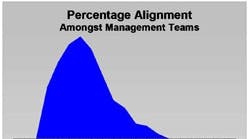In our engagements with companies both large and small, we have often come across managers who are frustrated with their teams' effectiveness. In our experience, this is not due to a lack of ability or desire, but rather stems from the lack of alignment amongst the various projects in the organization.
Most people will agree that being able to generate agreement amongst a team is one of the fundamental elements of good leadership. Generating alignment goes beyond simply creating consensus or agreement. As Fred Smith, Chairman of Federal Express has been repeatedly quoted as saying, "Alignment is the essence of management."
Alignment reflects an active ownership on the part of the team members, not simply the absence of disagreement. Many leaders fall into the trap of assuming their team is aligned because of a lack of any active disagreement, and therefore do not direct any energy at improving the leadership team's understanding of the business priorities.
The frustration that managers face with the ineffective use of resources is often due to a misperception of the clarity around the organization's top priorities. Simply relying on visible disagreement is not the most effective way to discern the true state of alignment amongst the different stakeholders. As one of our clients found: "I thought my team was perfectly aligned -- until I asked them what our top challenge was, and got five different answers from five different members of the team."
What it Means to Be a Well Aligned Organization
How would you like to lead an organization in which every individual knows the business' goals, vision, and top challenges? "If you could get all the people in an organization rowing in the same direction, you could dominate any industry, in any market, against any competition, at any time," according to Patrick Lencioni, Patrick, author of "The Five Dysfunctions of a Team".
All activities performed by individuals in a perfectly aligned organization help move the business closer to its strategic vision. By ensuring that teams at various levels in the organization are aligned on their goals, we can move the business towards a culture of "working towards objectives." This alignment amongst the teams will help drive actions that are necessary in the medium term to deliver the required results.
Developing a well-aligned organization depends on two critical factors: First, the systems and structures must support the strategic vision; and second, the members of the organization must understand how the top strategic objectives translate to personal goals. Alignment is an agreement on the goals of the organization and on the process of allocating resources to achieve these goals. The first step in improving this alignment is being able to understand the opportunity, which can exist even without visible dissagreement. This article will explore an exercise to help leaders measure the degree of alignment amongst their teams.
What this Means for Your Organization
We have often seen significant gaps in the understanding of an organization's top opportunities and management team members often have different views of the top priorities.
As part of a supply chain transformation, a food business required a 10% improvement in productivity at their largest facility. The management team supported the goal, but had not yet made tangible productivity improvements. Upon conducting a review of the various improvement projects, the general manager discovered an inadequate resource commitment from the broader organization to any of the initiatives. Without strong alignment on the path forward, each manager had been focused on "their ideas," and this lead to many disjointed and unsupported projects.
Evaluating Your Alignment
The question to ask is: How do you know if your team is aligned? If your management team is forthcoming with disagreement and debate about priorities then you know you have room to improve. If your team is not forthcoming with disagreement, then how do you determine whether your team is perfectly aligned or simply avoiding confrontation?
We have facilitated alignment exercises to help leaders at various levels in their organizations evaluate the alignment of their teams. As is evident in the graph to the right, we have found that all managers have a significant opportunity to improve the alignment amongst their teams.
The benefits of a well-aligned team are no surprise to anyone. A lot has been written about how to create better alignment within teams, through team building, incentives, and other management techniques. Improving the alignment of a group, however, must start with an honest evaluation of the current state, and a desire to improve. The purpose of the exercise contained in this article is to create this desire by highlighting the opportunity to improve the alignment of your team.
Evaluating Your Teams Alignment -- Exercise
1. Brainstorm the List of Opportunities
Have each member of your team identify the top 5-10 items on their list of opportunities in the area you are evaluating (for example, the top five ideas to improve customer satisfaction).
The items must be specific such as "reduce the amount of time customers spend in the queue," or "reduce the lead time on a product A." Avoid broad categories such as "improve customer service" or "reduce inventory."Have a facilitator write each of these opportunities on a flip chart with a letter assigned to it as shown in the example above. The brainstorm list should contain all the ideas that would need to be resourced by the team.
2. Prioritizing the List
In the next step of the exercise, each member of the team will anonymously select their top three priorities from the brainstorm list.
3. Evaluating the Alignment
In a perfectly aligned team, the members would each pick exactly the same three opportunities in exactly the same order. To determine your team's alignment, select one member to be the baseline for comparison.
The top opportunity in this comparison list will be worth 3 points, the second worth 2 points, and the third worth 1 point. Each of the other team members' prioritized lists will be scored based on these three opportunities. The average of these scores divided by the perfect (6) will give you your alignment score. A score of 75% or better is excellent and any score below 60% suggests a big opportunity to improve alignment.
Gaurav Gupta is the Lead Consultant at Stroud Consulting, an operations & management consulting firm. http://www.stroudconsulting.com/




